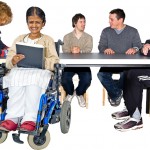
Learning Disability Partnership Boards have been in operation since 2001. They were established as a result of the Valuing People White Paper to oversee inter-agency planning and service development. Pivotal to their creation was the fact that the partnership had to involve a range of stakeholders, including service users, carers, and representatives from all the major service agencies.
In the current study, the researcher set out to look at how one of the partners – people with learning disabilities – have been involved in the boards, and whether this involvement has provided opportunities for them to take part in civic activities. To look at this issue, the researcher carried out systematic observations of five different partnership boards in the South East of England. In addition, she interviewed 55 members of partnership boards.
She found that the representatives with learning disabilities were able to contribute in four different ways:
- as co-chair of main meetings
- as a member responsible for a specific activity or role
- as a contributor to meetings and discussions
- as a presenter.
She concludes that people with learning disabilities were able to be involved in the work of partnership boards, but that their opportunities to influence outcomes were not fully recognised by others. The pace and complexity of meetings had proved difficult for some contributors. She points out though that consideration of these issues and the setting up of alternative arrangements can help people with learning disabilities to contribute more to the meetings and therefore to have more influence on outcomes.
Riddington C, “Ten years of partnership”, Tizard Learning Disability Review,.17: 1, 14 – 21
Keywords: Active citizens, Citizenship, Influencing outcomes, Intellectual disabilities, Learning disabilities, Learning disability partnership boards, Partnership, Valuing People
